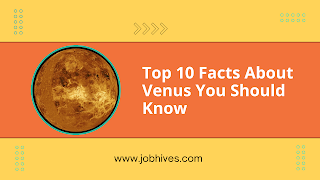Venus, the second planet from the Sun, is Earth's closest planetary neighbor and one of Earth's four inner, terrestrial rocky planets. Its dense atmosphere creates an extreme greenhouse effect, resulting in a mean temperature of 737 K (464 °C; 867 °F) and a crushing pressure of 92 times that of Earth's at sea level. Venus appears as either a "morning star" or an "evening star" and is the third brightest object in Earth's sky.
What is the atmosphere of Venus made up of?
Venus' atmosphere is primarily
supercritical carbon dioxide, denser and hotter than Earth's, with a surface
temperature of 740 K and 93 bar pressure. It contains small amounts of
nitrogen, sulfur dioxide, argon, water vapor, carbon monoxide, helium, neon,
hydrogen chloride, and hydrogen fluoride. The atmosphere supports opaque
sulfuric acid clouds, making optical Earth-based and orbital observation
impossible. The upper troposphere exhibits super-rotation, circling the planet
in just four Earth days.
Is there any possibility that humans can live on Venus?
Venus, a planet with a
surface temperature of 740 K and a pressure 93 times higher than Earth's, is a
potential location for humans. The atmosphere is primarily composed of
supercritical carbon dioxide, with small amounts of nitrogen, sulfur dioxide,
argon, water vapor, carbon monoxide, helium, neon, hydrogen chloride, and
hydrogen fluoride. Despite these conditions, some scientists speculate that
thermoacidophilic extremophile microorganisms might exist in the temperate,
acidic upper layers of Venus.
How long does it take for Venus to orbit around the Sun?
Venus orbits the Sun at an
average speed of 78,341 miles per hour or 126,077 kilometers per hour, taking
approximately 224.65 days to complete one Venusian year.
What are the top 10 facts about Venus planet?
Here
are 10 interesting facts about Venus:
- Named After the Goddess of Love and Beauty: Venus Planet is named after the Roman goddess of love and beauty because it is the brightest planet and was occasionally visible from Earth. Most features on the surface of Venus are named after female figures.
- Venus Planet Has No Rings or Moons: Venus and Mercury are the only planets in the Solar System without either a moon or a ring.
- Hottest Planet in the Solar System: Venus Planet is significantly warmer than Mercury, even though the latter is much closer to the Sun. The average surface temperature on Venus Planet is about 462 °C (864 °F).
- Venus Planet Has an Unusual Rotation: All planets spin in an anti-clockwise rotation and revolve around the Sun anti-clockwise, except Venus. The Venus planet revolves anti-clockwise but rotates clockwise.
- A UFO in the Sky: Venus Planet is so remarkably bright that some initially believed it was an unidentified flying object (UFO). The brightness of Venus is attributed to the dense cloud of sulfuric and carbon dioxide gases that reflects light from the Sun, making the planet visible from Earth.
- Active Volcanoes: Fresh lava flows through the surface of Venus, implying that volcanic eruptions are frequent and have been ongoing for millions of years.
- Spacecraft Grave: The atmosphere and surface of Venus are intolerable to both humans and machines.
- Venus Is Earth's Twin: Venus is often called Earth's twin because it's similar in size and density.
- Venus Has an Iron Core but No Magnetic Field: Unlike Earth, Venus does not have a magnetic field, despite having an iron core.
- Venus Spins Slowly: A day on Venus lasts
longer than a year on Venus! It takes approximately 243 Earth days for Venus to
complete one rotation on its axis, while it takes about 225 Earth days for
Venus to orbit around the Sun.




